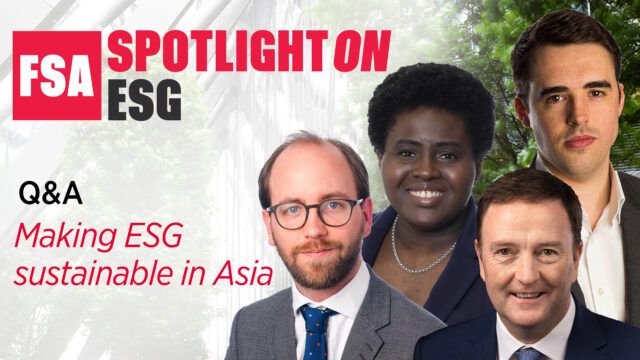The availability and standardisation of data, as well as consistent methodologies, present continued hurdles for sustainable investing. What’s the solution?

Noel: It is very important that companies disclose the information that investors need for their investment process and for their regulatory reporting, so we believe that in the European Union, for example, the implementation of its new Sustainable Taxonomy is facilitated by companies publishing the data that allows investors to determine the extent to which that company’s revenues can be deemed “sustainable”, according to that Taxonomy.
However, on the separate issue of ESG scores and ratings, from specialised ESG research firms, I don’t necessarily believe that every provider must or should use exactly the same methodology or that they should be expected to have the same rating for the same company. We don’t expect all (traditional) investment analysts to have the same price target or Buy/Sell rating for a company, so why should we expect all ESG analysts to have the same ESG score or rating for a company? It is, however, very important that there is full transparency of the methodology and data used to arrive at the rating.

Will: Absolutely, data is patchy, incomplete and imperfect. It was ever such. It is nonetheless improving. Slowly. That said, the lack of consistent and comparable data is not a barrier to thinking through how well a company is positioned in the face of the sustainability issues it confronts or has the opportunity to resolve and capitalise on. In the same way, a lack of data is not a barrier to engaging with company management and quizzing them around topics such as corporate culture and employee welfare. The insights from these dialogues can be as, if not more illuminating than any typically backward-looking data set.

Amarachi: The solution is for policymakers to get involved. We have seen this in Europe where we are now being regulated with two pieces of regulation- the EU taxonomy and the Sustainable Finance Disclosure Regulation. Both these regulations are looking to standardise our disclosures, and rightly so. Ultimately, what makes this question distressing, is that we as an industry have not been able to give our clients confidence in the data that we are producing to warrant autonomy. However, I am glad these issues are being addressed and we are seeing this take root in Asia. For example, Hong Kong’s SFC have put together standard requirements for ESG funds. We are also seeing a new international ISO standard is being created in sustainable finance, and I think a standard that covers the whole world and not just individual regions is a step in the right direction. And finally, enforcement is important too, and what we are seeing is greater enforcement in transparency and disclosures, and that’s important too. At the end of the day, it’s harmful not to be transparent.

Harry: Regulation is the solution for the availability and standardisation of data. The EU has taken a leadership role in driving this with its Non-Financial Reporting Directive which requires companies to disclose key performance indicators relating to the environment, social and employee issues, human rights, and bribery and corruption. Companies must further disclose how sustainability issues may affect the company, as well as how the company affects society and the environment. The EU’s Sustainable Finance Disclosure will further enhance fund-level disclosure of non-financial data.
Given the lack of uniform ESG standards, how can investors measure performance and relevance of ESG portfolios?

Noel: To some extent investors can look at externally calculated average ESG ratings for a portfolio, as calculated by providers like MSCI ESG Research, Sustainalytics, Morningstar and others. However, just as an investor would not necessarily invest into a portfolio solely because it has a low price earnings ratio or a high dividend yield, similarly it is wrong to rely on that external assessment only when looking at a portfolio. As with all aspects of portfolio analysis, it is important to look at a variety of metrics, including, yes, the average ESG score of the portfolio, but also its carbon footprint, the percentage of female board members, the percent of the portfolio invested in companies that are providing “clean” energy vs the percent invested in companies involved with fossil fuels, and a variety of other metrics which will vary depending on the nature of the portfolio. This isn’t a simple task for a retail investor, but it’s worth the effort!

Will: In my view portfolio ESG measurement is often mis-leading and irrelevant. Few ESG metrics are universally relevant and for those that perhaps are, as already discussed the data available on these is too imperfect and incomplete. Instead greater transparency over holdings and the rationales for their holding is I think the litmus test for portfolio managers of ESG portfolios.

Amarachi: The key thing that investors can do now is to just ask for data that makes sense. If you don’t find comparable data and are interested in a fund, ask the fund provider for the data. Additionally, investors can also have conversations with their data providers and exert pressure for uniformity of data between providers. A lot of the uniformity regulations in Europe are placed on the fund managers, very few are on the data providers, and that is a problem.

Harry: Our solution to the lack of uniformity of ESG standards is to show the performance of our companies through carbon emissions vs carbon avoided/SDG alignment/external ESG scores rather than to talk about the impact that our investments have had. We do, however, like to talk about impact in the context of our charitable donations which provide incremental dollars to environmental conservation.
The Fund Selector Asia Spotlight On: ESG will run on 13 – 16 Sept and ends with a LIVE event (on the 16th) where we will bring together a panel of fund selectors and the fund managers to discuss their views and join an interactive Q&A session.
Find out more about our Spotlight On: ESG here: https://fundselectorasia.com/spotlight-on/esg/





![Eastspring Asia sustainable bond product available in Hong Kong rong-ren-goh–846×790[1]](https://s34456.pcdn.co/wp-content/uploads/2020/10/rong-ren-goh-846x7901-1-156x111.jpg.optimal.jpg)











